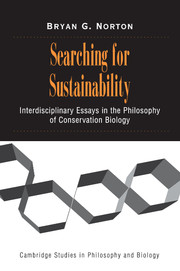Book contents
- Frontmatter
- Contents
- Searching for Sustainability
- General Introduction: An Interdisciplinary Experiment
- I PRAGMATISM AS AN ENVIRONMENTAL PHILOSOPHY
- II SCIENCE, POLICY, AND POLICY SCIENCE
- III ECONOMICS AND ENVIRONMENTAL SUSTAINABILITY
- IV SCALING SUSTAINABILITY: ECOLOGY AS IF HUMANS MATTERED
- V SOME ELEMENTS OF A PHILOSOPHY OF SUSTAINABLE LIVING
- 20 Caring for Nature: A Broader Look at Animal Stewardship
- 21 Can There Be a Universal Earth Ethic? A Reflection on Values for the Proposed Earth Charter
- 22 Intergenerational Equity and Sustainability
- VI VALUING SUSTAINABILITY: TOWARD A MORE COMPREHENSIVE APPROACH TO ENVIRONMENTAL EVALUATION
- Index
- References
20 - Caring for Nature: A Broader Look at Animal Stewardship
Published online by Cambridge University Press: 21 January 2010
- Frontmatter
- Contents
- Searching for Sustainability
- General Introduction: An Interdisciplinary Experiment
- I PRAGMATISM AS AN ENVIRONMENTAL PHILOSOPHY
- II SCIENCE, POLICY, AND POLICY SCIENCE
- III ECONOMICS AND ENVIRONMENTAL SUSTAINABILITY
- IV SCALING SUSTAINABILITY: ECOLOGY AS IF HUMANS MATTERED
- V SOME ELEMENTS OF A PHILOSOPHY OF SUSTAINABLE LIVING
- 20 Caring for Nature: A Broader Look at Animal Stewardship
- 21 Can There Be a Universal Earth Ethic? A Reflection on Values for the Proposed Earth Charter
- 22 Intergenerational Equity and Sustainability
- VI VALUING SUSTAINABILITY: TOWARD A MORE COMPREHENSIVE APPROACH TO ENVIRONMENTAL EVALUATION
- Index
- References
Summary
The naturalist writer Annie Dillard poignantly poses a central moral issue of our time in a chapter on the fecundity of nature (Dillard 1974). She notes that the rock barnacles on a short stretch of rocky seashore pour forth a million million larvae, of which only a few will survive to maturity. Nature, she notes, apparently cares not a whit about individuals. But all modern Western systems of ethics value individuals above all. “Either this world, my mother, is a monster, or I myself am a freak,” Dillard laments. Dillard's point might be stated more calmly as a concern about how broadly to apply traditional concepts of justice when our actions have sometimes terrible impacts on members of other species.
As the crisis of biodiversity unfolds over coming decades, conservationists will advocate more and more invasive methods to save in captivity species that are threatened in the wild. As habitat alteration and fragmentation continue, more and more interventions in the lives of wild animals will be required if their wild populations are to be protected and kept in ecological balance. Actions taken to protect species and ecological communities may not be in the interest of individual members (Hutchins and Wemmer 1987). The recommendations of captive breeders and conservation biologists therefore conflict in many cases with the recommendations of animal welfare advocates (Ehrenfeld 1991).
The excruciating policy questions addressed in this book stem from Dillard's dilemma: committed conservationists tend to concentrate on the protection of populations, species, ecosystems, and processes.
- Type
- Chapter
- Information
- Searching for SustainabilityInterdisciplinary Essays in the Philosophy of Conservation Biology, pp. 375 - 395Publisher: Cambridge University PressPrint publication year: 2002



